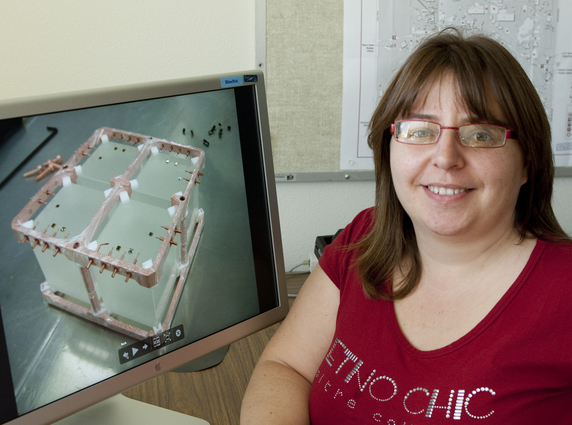Postdoc gets to the "heart" of anti-matter in CUORE experiment
Marisa Pedretti, a post-doctoral researcher since January 2009 in the Experimental Nuclear Physics group of the Physics Division of the Physical and Life Sciences Directorate, was recently selected as the experimental coordinator for the CUORE-0 tower that consists of 52 tellurium dioxide crystal bolometers to measure radiation.
What is CUORE?
CUORE-0 is the first step toward the realization of the Cryogenic Underground Observatory for Rare Events (CUORE) located at the underground Laboratori Nazionali del Gran Sasso, in Italy. (The word 'cuore' means heart in Italian.)
The project, funded at LLNL by the Department of Energy's Office of Science and LDRD, involves searching for an extremely rare radioactive process known as neutrinoless double-beta decay. The experiment brings together more than 100 U.S. and European scientists to build a 1-ton detector array.
Lawrence Livermore along with Lawrence Berkeley national laboratories, and several U.S. universities, including the University of California at Berkeley, University of California at Los Angeles and CalPoly, are involved in the CUORE collaboration. Pedretti had done some work previously on the CUORE project in Italy, and then was approached to come to the United States to similar work here. As experimental coordinator, she will play a leadership role in the CUORE-0 commissioning, operation and overall scientific program.
This double beta decay experiment is designed primarily to search for the neutrinoless double decay of Tellurium-130 , one of a few isotopes with high isotopic abundance that allows high sensitivy. It will use a bolometric technique to measure the temperature changes produced in large crystals of tellurium dioxide when radiation is absorbed.
The CUORE detector will contain an array of nearly 1,000 tellurium dioxide crystals, each a 5-centimeter cube. The crystals will be cooled to 0.01 degrees above absolute zero. At this temperature, each crystal's heat capacity is small enough that the energy from a single radioactive decay within the crystal will be detected. Sensitive thermometers outside the crystals will indicate a change in temperature, which will then be used to determine the decay energy.
According to Pedretti, who has conducted prior research in detection, the CUORE project explores a new area of physics --- the search for neutrinoless double beta decay, a process which only recently has become a highlight of nuclear physics.
"When we look at fundamentals of physics, we use a physics model called the 'Standard Model (SM)'. But we know it is not perfect," Pedretti said. "Many things are not completely clear. New models and ideas have been proposed to answer the questions left open by the SM. To understand which of these models explains reality, we have to compare their predictions with reality, in other words with the results coming from experiments that aim to test that areas of physics where the SM can fail. Here, the neutrino plays a fundamental role, and in particular some of the properties of this particle are crucial."
In standard double-beta decay, two neutrons in a nucleus are converted to two protons, emitting two beta particles and two neutrinos that share the energy generated from the decay.
In neutrinoless decay, the neutrinos annihilate each other instead of being emitted, and the full energy - a little over 2 megaelectronvolt s- is carried away by the beta particles. This decay can only occur if a neutrino and its antimatter, the antineutrino, are the same particle.
Pedretti said that the neutrinoless double-beta decay experiments at CUORE could reveal unique properties of neutrinos that no other experiments have demonstrated thus far.
Life in the United States
Pedretti who hails from Piacenza in northern Italy, received her undergraduate degree in nuclear physics from the University of Milan in 2000, and a Ph.D. in physics from the University of Insubria in 2004.
As a young student, she switched her concentration from business to math and physics. Coming from Italy, it is no wonder that her hero is Italian physicist and Nobel Prize winner Enrico Fermi.
"A genius," she says of Fermi, but adds that he was much more -- he influenced and schooled many young scientists. "He collaborated with many students and in doing so, helped them to become leaders in their own fields of science."
This is the first time Pedretti has lived in the United States, and although she previously would have been content to remain in Italy where she was established within the European scientific community, she has found many more opportunities to pursue at LLNL and has gained a lot of confidence.
Her colleagues in Experimental Nuclear Physics led by Mark Stoyer, have helped her settle in and understand Lab procedures and processes. One facet of the Lab's postdoc program that she particularly appreciates is the ability to spend 25 percent of time in another area of interest, outside her specified field.
"I really enjoy working at LLNL and I feel that I am really taking care of my career here," she said. "Everyone is very helpful."
Pedretti has noticed the cultural differences between Italy and the United States in many ways. "Here, unlike in Italy, young people have many possibilities. If they want to change their career focus, they can," she remarks about the ease with which people not only change jobs, but move to various locations.
About CUORE, she emphasizes, "It is important that we are able to do this experiment -- it is fast and efficient and will explore a region of physics that is unknown. "
"If you ask me how this (CUORE) experiment will change your life -- I can tell you, it is not an invention like the microwave oven, I mean with an immediate application. But we are on the edge of pushing many aspects of the technology and we must remember there are always byproducts and discoveries that come from science," Pedretti says. "Just look at what products came from men landing on the moon."
Contact
Linda A Lucchetti[email protected]
925-422-5815
Tags
Academic EngagementPostdocs
Featured Articles









